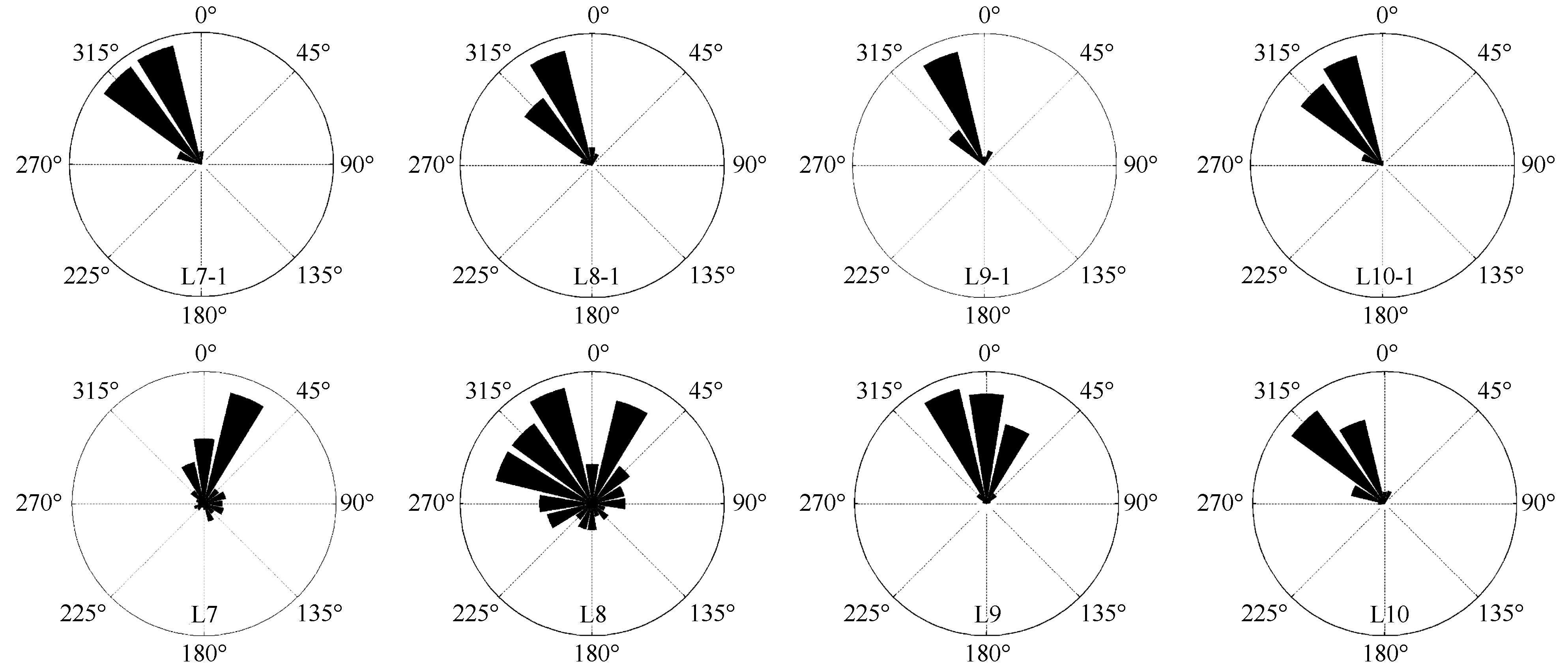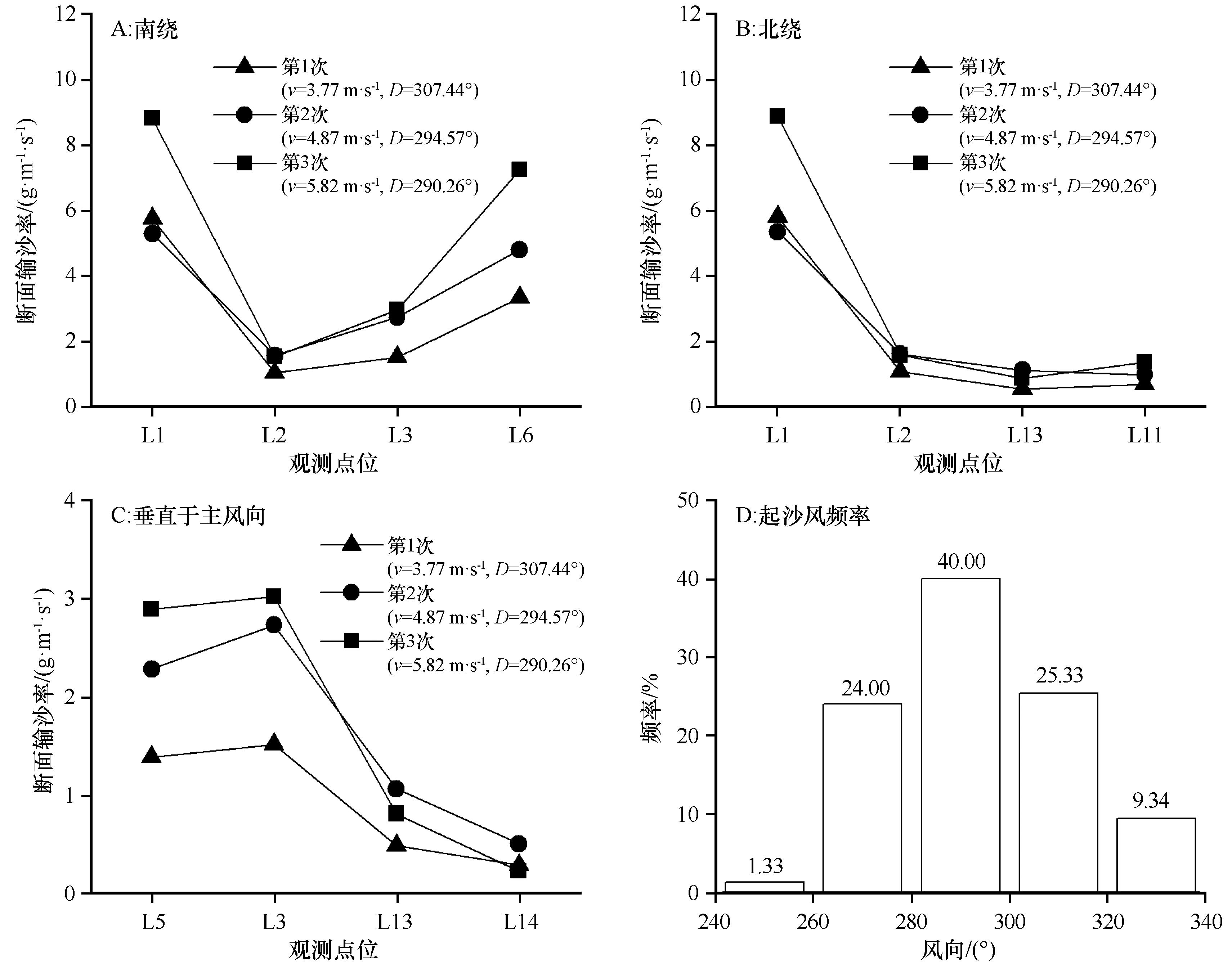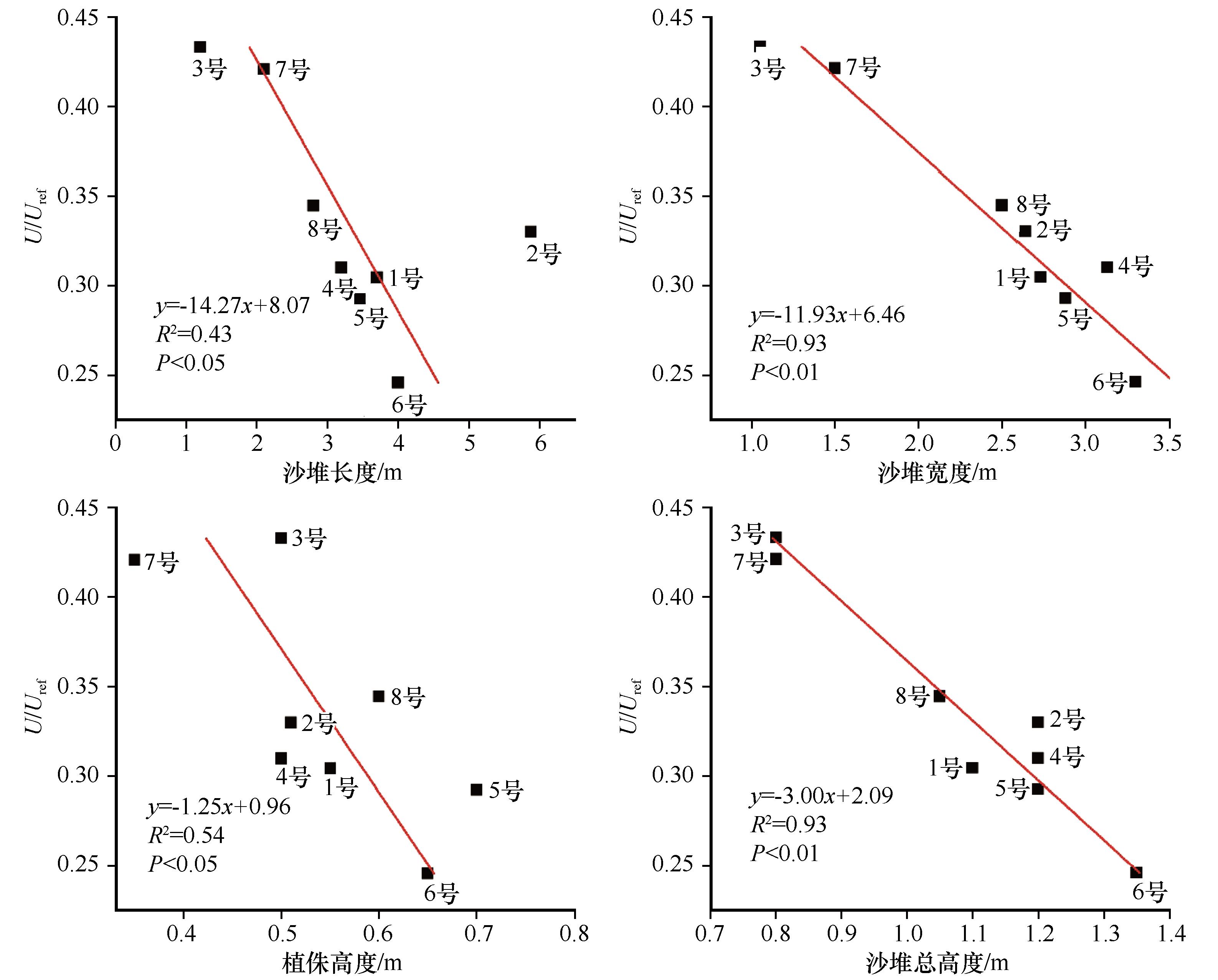中国沙漠 ›› 2022, Vol. 42 ›› Issue (1): 184-195.DOI: 10.7522/j.issn.1000-694X.2021.00208
• • 上一篇
殷婕1( ), 哈斯额尔敦null1(
), 哈斯额尔敦null1( ), 安晶2, 周炎广1, 胡日娜1, 武子丰1
), 安晶2, 周炎广1, 胡日娜1, 武子丰1
收稿日期:2021-10-26
修回日期:2021-12-13
出版日期:2022-01-20
发布日期:2022-01-28
通讯作者:
哈斯额尔敦null
作者简介:哈斯额尔敦(E-mail: hasi@bnu.edu.cn)基金资助:
Jie Yin1( ), Hasi Eerdun1(
), Hasi Eerdun1( ), Jing An2, Yanguang Zhou1, Rina Hu1, Zifeng Wu1
), Jing An2, Yanguang Zhou1, Rina Hu1, Zifeng Wu1
Received:2021-10-26
Revised:2021-12-13
Online:2022-01-20
Published:2022-01-28
Contact:
Hasi Eerdun
摘要:
鄂尔多斯高原广泛分布的油蒿(Artemisia ordosica)灌丛与风沙流相互作用形成灌丛沙堆,其形态发育主要受控于周围风沙输移状况。利用EC9-1型风向风速传感器和阶梯式集沙仪对平坦覆沙地上油蒿灌丛沙堆周围的风沙气流进行了观测,系统地分析了近地表水平流场、风速廓线和输沙率的分布和变化特征。结果表明:气流结构和输沙率随沙堆位置而变化。自灌丛沙堆迎风侧经两侧至背风侧,气流呈现分离降速、两侧增速、汇集减速的水平分布特征;风速在背风侧坡脚处最小,并随水平距离呈指数关系逐步回增,至4.85H(H是灌丛沙堆总高度)处恢复至旷野风速;灌丛沙堆周围风速廓线均不服从对数变化规律,且在背风侧坡脚0.3—1.0 m内风速随高度增加而减小,出现反向垂直轴涡流;相对于沙堆走向南北侧的起沙风频率差异使两侧输沙率变化不同,进而导致蚀积状态差异,沙堆平面形态由椭圆形向不对称纺锤形逐渐演化;沙堆背风侧均未出现沙尾,即在薄层覆沙剥蚀高原上不充足的沙源和入射风方向变化抑制了沙尾或风影沙丘的发育。
中图分类号:
殷婕, 哈斯额尔敦null, 安晶, 周炎广, 胡日娜, 武子丰. 鄂尔多斯高原油蒿(Artemisia ordosica)灌丛沙堆风沙气流结构及其地貌学意义[J]. 中国沙漠, 2022, 42(1): 184-195.
Jie Yin, Hasi Eerdun, Jing An, Yanguang Zhou, Rina Hu, Zifeng Wu. Geomorphologic significance of airflow and sand transport around an Artemisia ordosica nebkha in the Ordos Plateau, China[J]. Journal of Desert Research, 2022, 42(1): 184-195.
| 灌丛沙堆 序号 | 长度 /m | 宽度 /m | 总高度 /m | 灌丛植株 高度/m |
|---|---|---|---|---|
| 1 | 3.70 | 2.73 | 1.10 | 0.55 |
| 2 | 5.88 | 2.64 | 1.20 | 0.51 |
| 3 | 1.20 | 1.05 | 0.80 | 0.50 |
| 4 | 3.20 | 3.13 | 1.20 | 0.50 |
| 5 | 3.46 | 2.88 | 1.20 | 0.70 |
| 6 | 4.00 | 3.30 | 1.35 | 0.65 |
| 7 | 2.10 | 1.50 | 0.80 | 0.35 |
| 8 | 2.80 | 2.50 | 1.05 | 0.60 |
表1 灌丛沙堆形态参数
Table 1 Morphological parameters of each nebkha
| 灌丛沙堆 序号 | 长度 /m | 宽度 /m | 总高度 /m | 灌丛植株 高度/m |
|---|---|---|---|---|
| 1 | 3.70 | 2.73 | 1.10 | 0.55 |
| 2 | 5.88 | 2.64 | 1.20 | 0.51 |
| 3 | 1.20 | 1.05 | 0.80 | 0.50 |
| 4 | 3.20 | 3.13 | 1.20 | 0.50 |
| 5 | 3.46 | 2.88 | 1.20 | 0.70 |
| 6 | 4.00 | 3.30 | 1.35 | 0.65 |
| 7 | 2.10 | 1.50 | 0.80 | 0.35 |
| 8 | 2.80 | 2.50 | 1.05 | 0.60 |
| 入射风 | 指标 | 参考点 | 南侧观测点 | 北侧观测点 | ||||||
|---|---|---|---|---|---|---|---|---|---|---|
| L1 | L3 | L4 | L6 | L13 | L12 | L11 | ||||
| 同侧风 | 平均风速/(m·s-1) | 4.5 | 4.7 | 3.0 | 1.5 | 3.6 | 4.6 | 4.6 | ||
| 平均风速变幅/% | — | 5.9 | -33.7 | -66.3 | -19.0 | 2.3 | 4.1 | |||
| 异侧风 | 平均风速/(m·s-1) | 4.1 | 4.6 | 2.1 | 1.6 | 4.0 | 4.8 | 3.6 | ||
| 平均风速变幅/% | — | 11.3 | -49.6 | -61.9 | -4.2 | 16.7 | -12.1 | |||
表2 灌丛沙堆两侧观测点平均风速变化幅度
Table 2 Variation range of average wind speed at observation points on both sides of the nebkha
| 入射风 | 指标 | 参考点 | 南侧观测点 | 北侧观测点 | ||||||
|---|---|---|---|---|---|---|---|---|---|---|
| L1 | L3 | L4 | L6 | L13 | L12 | L11 | ||||
| 同侧风 | 平均风速/(m·s-1) | 4.5 | 4.7 | 3.0 | 1.5 | 3.6 | 4.6 | 4.6 | ||
| 平均风速变幅/% | — | 5.9 | -33.7 | -66.3 | -19.0 | 2.3 | 4.1 | |||
| 异侧风 | 平均风速/(m·s-1) | 4.1 | 4.6 | 2.1 | 1.6 | 4.0 | 4.8 | 3.6 | ||
| 平均风速变幅/% | — | 11.3 | -49.6 | -61.9 | -4.2 | 16.7 | -12.1 | |||

图7 背风侧各测点(L7—L10)及同时段参考点(L7-1—L10-1)的风向变化
Fig.7 Change of wind direction on the lee of each observation point (L7—L10) and reference point (L7-1—L10-1) in the same time
| 风向 | a | b | R2 | P | D/m |
|---|---|---|---|---|---|
| 292° | 0.0979 | 0.6698 | 0.9951 | 0.0009 | 5.6540 |
| 303° | 0.0938 | 0.6531 | 0.9933 | 0.0013 | 5.8641 |
| 315° | 0.0629 | 0.7118 | 0.9880 | 0.0023 | 5.9419 |
| 326° | 0.0126 | 0.9787 | 0.9698 | 0.0058 | 5.9644 |
| 337° | 0.0004 | 1.5710 | 0.9438 | 0.0108 | 5.9117 |
| 348° | 0.0005 | 1.6218 | 0.9181 | 0.0157 | 5.5889 |
表3 背风侧各测点0.3 m高度平均风速与距离之间的关系(y=a·ebx)
Table 3 The relationship(y=a·ebx) between the average wind speed at 0.3 m and distance on the leeward side of the nebkha
| 风向 | a | b | R2 | P | D/m |
|---|---|---|---|---|---|
| 292° | 0.0979 | 0.6698 | 0.9951 | 0.0009 | 5.6540 |
| 303° | 0.0938 | 0.6531 | 0.9933 | 0.0013 | 5.8641 |
| 315° | 0.0629 | 0.7118 | 0.9880 | 0.0023 | 5.9419 |
| 326° | 0.0126 | 0.9787 | 0.9698 | 0.0058 | 5.9644 |
| 337° | 0.0004 | 1.5710 | 0.9438 | 0.0108 | 5.9117 |
| 348° | 0.0005 | 1.6218 | 0.9181 | 0.0157 | 5.5889 |

图10 各测点输沙率变化(A—C)及对应观测期间起沙风风向频率(D)
Fig.10 Variation of sediment transport rate at observation points (A-C) and the frequency diagram of sand driving wind direction (D)
| 观测点位 | a | b | R2 | P |
|---|---|---|---|---|
| L1 | 3.4838 | 0.2607 | 0.9990 | 0.0000 |
| L2 | 0.6261 | 0.2336 | 0.9709 | 0.0000 |
| L4 | 1.0607 | 0.2141 | 0.9865 | 0.0000 |
| L5 | 1.0153 | 0.2277 | 0.9961 | 0.0000 |
| L6 | 2.4160 | 0.2306 | 0.9975 | 0.0000 |
| L11 | 0.3736 | 0.1962 | 0.9726 | 0.0000 |
| L12 | 0.2711 | 0.1678 | 0.9725 | 0.0000 |
| L14 | 0.0784 | 0.1329 | 0.9760 | 0.0000 |
表4 各测点输沙率随高度变化关系的拟合系数
Table 4 The fitting coefficient of the relationship between sediment transport rate and height at each observation point
| 观测点位 | a | b | R2 | P |
|---|---|---|---|---|
| L1 | 3.4838 | 0.2607 | 0.9990 | 0.0000 |
| L2 | 0.6261 | 0.2336 | 0.9709 | 0.0000 |
| L4 | 1.0607 | 0.2141 | 0.9865 | 0.0000 |
| L5 | 1.0153 | 0.2277 | 0.9961 | 0.0000 |
| L6 | 2.4160 | 0.2306 | 0.9975 | 0.0000 |
| L11 | 0.3736 | 0.1962 | 0.9726 | 0.0000 |
| L12 | 0.2711 | 0.1678 | 0.9725 | 0.0000 |
| L14 | 0.0784 | 0.1329 | 0.9760 | 0.0000 |

图12 背风侧坡脚相对风速(背风侧坡脚风速U与上风向参考点L1的0.3 m高度风速Uref的比值)与灌丛沙堆形态参数之间的关系
Fig.12 The relationship between relative wind speed at the toe of leeward slope and morphological parameters of nebkhas
| 1 | Tsoar H,Blumberg D G.Formation of parabolic dunes from barchan and transverse dunes along Israel's Mediterranean coast[J].Earth Surface Processes and Landforms,2002,27(11):1147-1161. |
| 2 | 张萍,哈斯,杜会石,等.抛物线形沙丘与油蒿灌丛之间的动态关系[J].科学通报,2011,56(35):3003-3010. |
| 3 | Tengberg A.Nebkha dunes as indicators of wind erosion and land degradation in the Sahel zone of Burkina Faso[J].Journal of Arid Environments,1995,30(3):265-282. |
| 4 | 岳兴玲,哈斯,庄燕美,等.沙质草原灌丛沙堆研究综述[J].中国沙漠,2005,25(5):738-743. |
| 5 | Liu B,Zhao W Z,Yang R.Characteristics and spatial heterogeneity of Tamarix ramosissima Nebkhas in desert-oasis ecotones[J].Acta Ecologica Sinica,2008,28(4):1446-1455. |
| 6 | 孙涛,唐进年,韩福贵,等.旱区荒漠灌丛沙堆研究进展及展望[J].水土保持通报,2016,36(4):351-356. |
| 7 | 哈斯,杜会石,孙禹.内蒙古高原小叶锦鸡儿(Caragana microphylla)灌丛沙丘:形态特征及表面气流[J].第四纪研究,2013,33(2):314-324. |
| 8 | Tengberg A,Chen D L.A comparative analysis of nebkhas in central Tunisia and northern Burkina Faso[J].Geomorphology,1998,22(2):181-192. |
| 9 | Hesp P,Mclachlan A.Morphology,dynamics,ecology and fauna of Arctotheca populifolia and Gazania rigens nabkha dunes[J].Journal of Arid Environments,2000,44(2):155-172. |
| 10 | Cheng H,Zhang K,Liu C,et al.Wind tunnel study of airflow recovery on the lee side of single plants[J].Agricultural and Forest Meteorology,2018,263:362-372. |
| 11 | Hesp P,Smyth T A G.Nebkha flow dynamics and shadow dune formation[J].Geomorphology,2017,282:27-38. |
| 12 | 张文,亢力强,张琴,等.植株形态对单植株前后风速变化影响的风洞实验[J].北京师范大学学报(自然科学版),2020,56(4):573-581. |
| 13 | Miri A,Dragovich D,Dong Z B.Wind flow and sediment flux profiles for vegetated surfaces in a wind tunnel and field-scale windbreak[J].Catena,2021,196. |
| 14 | 亢力强,杨智成,张军杰,等.两种柔性植株地表风速廓线特征比较的风洞模拟[J].中国沙漠,2020,40(2):43-49. |
| 15 | Gillies J A,Nield J M,Nickling W G.Wind speed and sediment transport recovery in the lee of a vegetated and denuded nebkha within a nebkha dune field[J].Aeolian Research,2014,12:135-141. |
| 16 | Mayaud J R,Wiggs G F S,Bailey R M.Characterizing turbulent wind flow around dryland vegetation[J].Earth Surface Processes and Landforms,2016,41(10):1421-1436. |
| 17 | 安晶,哈斯,杜会石,等.内蒙古高原小叶锦鸡儿灌丛沙堆对气流结构与风蚀的影响[J].干旱区研究,2015,32(2):304-312. |
| 18 | Zhao Y C,Gao X,Lei J Q,et al.Field measurements of turbulent flow structures over a nebkha[J].Geomorphology,2020,375(11):10755. |
| 19 | 李秋爽,张超,王飞,等.鄂尔多斯高原油蒿种群分布格局对降水梯度的反应[J].应用生态学报,2009,20(9):2105-2110. |
| 20 | 李柳,李小雁,马育军,等.油蒿灌木的生态水文过程研究综述[J].干旱气象,2013,31(4):814-819. |
| 21 | Neuman C M,Bedard O.A wind tunnel study of flow structure adjustment on deformable sand beds containing a surface-mounted obstacle[J].Journal of Geophysical Research-Earth Surface,2015,120(9):1824-1840. |
| 22 | Dong Z B,Luo W Y,Qian G Q,et al.Wind tunnel simulation of the three-dimensional airflow patterns around shrubs[J].Journal of Geophysical Research-Earth Surface,2008,113(F2). |
| 23 | Lancaster N,Baas A.Influence of vegetation cover on sand transport by wind:field studies at Owens Lake,California[J].Earth Surface Processes and Landforms,2015,23(1):69-82. |
| 24 | Zhao Y C,Gao X,Lei J Q,et al.Effects of wind velocity and nebkha geometry on shadow dune formation[J].Journal of Geophysical Research-Earth Surface,2019,124(11):2579-2601. |
| 25 | Charbonneau B R,Dohner S M,Wnek J P,et al.Vegetation effects on coastal foredune initiation:wind tunnel experiments and field validation for three dune-building plants[J].Geomorphology,2021,378:107594. |
| 26 | 谭凤翥,王雪芹,王海峰,等.柽柳灌丛沙堆三维流场随背景植被变化的风洞实验[J].中国沙漠,2018,38(1):48-57. |
| 27 | Mayaud J R,Bailey R M,Wiggs G F S.A coupled vegetation/sediment transport model for dryland environments[J].Journal of Geophysical Research-Earth Surface,2017,122(4):875-900. |
| 28 | Kuroyama Y,Mochizuki N,Nakashima T.Influence of vegetation on aeolian sand transport rate from a backshore to a foredune at Hasaki,Japan[J].Sedimentology,2005,52(5):1123-1132. |
| 29 | Wasson R J,Nanninga P M.Estimating wind transport of sand on vegetated surfaces[J].Earth Surface Processes and Landforms,1986,11(5):505-514. |
| 30 | 武胜利,李志忠,海鹰,等.新疆和田河流域单株柽柳灌丛流场的实验研究[J].干旱区研究,2006(4):539-543. |
| 31 | 张萍,哈斯,吴霞,等.单个油蒿灌丛沙堆气流结构的野外观测研究[J].应用基础与工程科学学报,2013,21(5):881-889. |
| 32 | Hesp P.The formation of shadow dunes[J].Journal of Sedimentary Petrology,1981,51(1):101-112. |
| 33 | Yang Y Y,Liu L Y,Shi P J,et al.Converging effects of shrubs on shadow dune formation and sand trapping[J].Journal of Geophysical Research-Earth Surface,2019,124(7):1835-1853. |
| 34 | 蔡东旭,李生宇,刘耀中,等.台特玛湖干涸湖盆区植物风影沙丘的形态特征[J].干旱区地理,2017,40(5):1020-1028. |
| 35 | Zhao Y C,Gao X,Lei J Q,et al.Nebkha alignments and their implications for shadow dune elongation under unimodal wind regime[J].Geomorphology,2020,365:107250. |
| [1] | 王仁德, 安晨宇, 苑依笑, 张春来, 李庆, 查慧敏, 常春平, 郭中领. 不同时间尺度下农田土壤风蚀可蚀性的变化[J]. 中国沙漠, 2021, 41(5): 202-209. |
| [2] | 刘箴言, 常春平, 郭中领, 李继锋, 王仁德, 李庆, 黄亚鹏, 李旭, 刘珺, 苏振生. 3类集沙仪野外测试对比[J]. 中国沙漠, 2020, 40(6): 33-42. |
| [3] | 胡菲, 张克存, 安志山, 鱼燕萍. 敦煌沙漠、绿洲和戈壁地表风动力环境特征同步对比[J]. 中国沙漠, 2020, 40(4): 113-119. |
| [4] | 肖锋军, 董治宝, 郭烈锦, 王跃社, 李德标. 风沙流中跃移沙粒冲击速度和角度联合概率分布风洞实验[J]. 中国沙漠, 2020, 40(3): 127-134. |
| [5] | 亢力强, 杨智成, 张军杰, 邹学勇, 张文. 两种柔性植株地表风速廓线特征比较的风洞模拟[J]. 中国沙漠, 2020, 40(2): 43-49. |
| [6] | 鱼燕萍, 肖建华, 屈建军, 李芳, 李万强, 潘多明, 吴青瑞, 洪雪峰, 田永祯. 两种典型高等级公路路基断面风沙过程的风洞模拟[J]. 中国沙漠, 2019, 39(1): 68-79. |
| [7] | 杨欢, 李玉强, 王旭洋, 牛亚毅, 龚相文, 余沛东. 半干旱区不同类型沙丘风沙流结构特征[J]. 中国沙漠, 2018, 38(6): 1144-1152. |
| [8] | 鱼燕萍, 肖建华, 屈建军, 魏明年, 潘多明, 洪雪峰, 田永祯, 李芳. 不同坡角公路路基流场的风洞实验[J]. 中国沙漠, 2018, 38(3): 464-472. |
| [9] | 郭彩贇, 韩致文, 李爱敏, 钟帅. 库布齐沙漠110 MW光伏基地次生风沙危害的动力学机制[J]. 中国沙漠, 2018, 38(2): 225-232. |
| [10] | 杨转玲, 钱广强, 董治宝, 罗万银, 张正偲, 逯军峰, 李继彦. 库姆塔格沙漠北部三垄沙地区风沙运动特征[J]. 中国沙漠, 2018, 38(1): 58-67. |
| [11] | 袁方, 张振师, 卜崇峰, 杨延哲, 苑森朋. 毛乌素沙地光伏电站项目区风速流场及风蚀防治措施[J]. 中国沙漠, 2016, 36(2): 287-294. |
| [12] | 陶彬彬, 哈斯额尔敦, 乌格特茉勒, 管超. 库布齐沙漠南缘抛物线形沙丘表面风速与输沙率的变异[J]. 中国沙漠, 2015, 35(6): 1445-1452. |
| [13] | 胡广录, 王德金, 廖亚鑫, 樊立娟, 张宏伟. 气象因子对黑河中游荒漠-绿洲过渡带斑块植被区风沙活动的影响[J]. 中国沙漠, 2015, 35(4): 865-873. |
| [14] | 王康龙, 武建军, 罗生虎. 风沙运动的欧拉双流体模型参数研究[J]. 中国沙漠, 2014, 34(6): 1461-1468. |
| [15] | 刘芳, 郝玉光, 辛智鸣, 陈海玲, 徐军, 赵英铭. 乌兰布和沙漠东北缘地表风沙流结构特征[J]. 中国沙漠, 2014, 34(5): 1200-1207. |
| 阅读次数 | ||||||
|
全文 |
|
|||||
|
摘要 |
|
|||||
©2018中国沙漠 编辑部
地址: 兰州市天水中路8号 (730000)
电话:0931-8267545
Email:caiedit@lzb.ac.cn;desert@lzb.ac.cn
